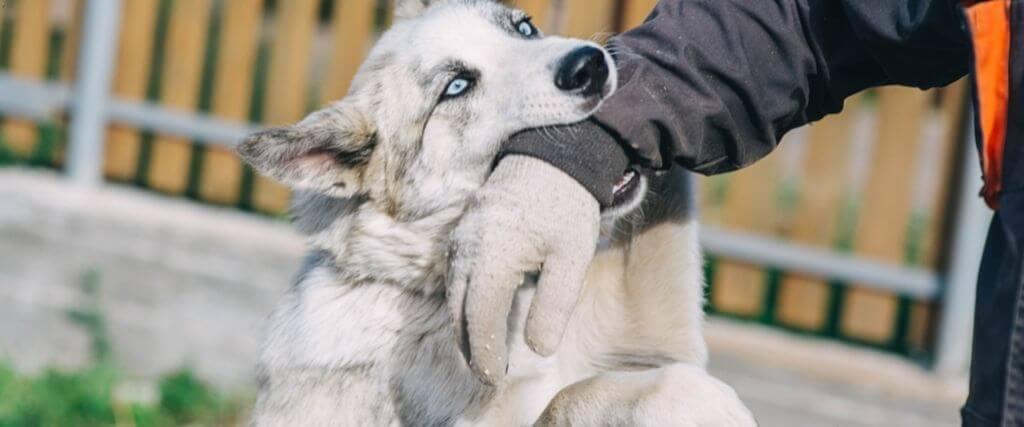More than 4.5 million Americans are bitten by dogs each year. And of them, over 800,000 seek medical attention. No matter how much we love our canine companions, dog bites threaten public health and safety.
Far too many dogs are surrendered or euthanized due to biting. Fortunately, many bites are preventable. Understanding why dogs bite and how to avoid dangerous situations is the best way to minimize your risk. Whether it’s your dog or an unfamiliar dog, following the tips below will help you stay safe.
Why Dogs Bite
Dogs bite for several reasons. Most often, though, doing so is a reaction to something. A bite may occur when a dog is defending their territory, food, toys, puppies, or themself from a real or perceived threat. Dogs also bite when frightened or feeling unwell.
Nipping and biting are normal behaviors in puppies. When their owners don’t teach them that these behaviors are inappropriate while still puppies, they may continue biting during play as adults. And what may have been a playful nip in your dog’s younger days could be a painful bite later on. Teaching your puppy not to bite is an essential part of raising a well-mannered dog and minimizing the risk of bites.
In addition to teaching your dog about acceptable behavior while young, below are a few other ways to prevent bites.
Be a Responsible Pet Parent
Owning a dog (or any other pet) is a big responsibility, so adopting a canine companion isn’t a decision to make on a whim. Being a responsible pet parent is about more than giving your furry friend lots of attention and enjoying rollicking games of fetch in the backyard. It’s also about providing everything your dog needs to enjoy a healthy, happy, and well-adjusted life.
Responsible pet ownership starts with selecting a dog that’s right for your family. Not every breed is suitable for every household. No matter how cute they are, a tiny Yorkie or Chihuahua likely isn’t the best choice for an active family with several small children. And a working breed, like a German Shepherd and Border Collie, isn’t well-suited to families who don’t have the time or energy to keep up with their demanding exercise needs. Do your homework, and choose a dog breed that will be a good fit for your family.
The hard work doesn’t stop there! Once your new canine companion has joined the family, you still need to train them, make sure they get enough physical and mental exercise and stay on top of their veterinary needs. Dogs who are well-trained, stay active, and are in optimal health are much less likely to bite. Having them spayed or neutered can lower their bite risk, too.
Socialize Your Dog
Fear and anxiety are among the most common reasons for dog bites. Unfortunately, dogs who lack socialization often find seemingly mundane situations frightening or uncomfortable. Socializing your puppy helps them feel more at ease when they are older and lowers the risk of bites.
Introduce your puppy to various people and animals, and keep every interaction positive. Offer plenty of praise to show them that meeting strangers is a fun and rewarding experience. Once fully vaccinated, take your canine companion with you when visiting public places that welcome pets. The more experiences you can give your pup when they’re young, the calmer and less reactive they’ll likely be as an adult.
Educate Your Kids
Dogs are excellent companions for kids, but they are not toys. Children are the most common dog bite victims, and many bites occur because they’ve never learned how to interact with dogs appropriately. Lack of supervision is a common cause, too, especially of bites involving younger kids.
Teach your child to treat your dog and other familiar dogs gently and respectfully. Never allow them to climb on, ride, or tease your dog. If your dog is crate trained, help your little one understand that the crate is a space where your dog can go to spend time alone.
Teaching your kids how to safely interact with familiar and unfamiliar dogs is crucial in keeping them safe. Doing so can save a dog’s life, too. Don’t allow your child to approach strange dogs. If they want to pet a dog, teach them to ask the owner first. Instruct them to calmly and quietly walk away if approached by an unfamiliar dog. If the dog is aggressive, teach them to stand still and look downward and to the side rather than running away, yelling, striking at the dog, or making sudden movements that could escalate the situation.
Avoid Petting in Potentially Dangerous Situations
Even the friendliest dog may bite when in an uncomfortable or unfamiliar situation. No matter how much you want to pet a dog, doing so is dangerous in certain scenarios.
Some situations when you should avoid petting a dog include:
- The dog isn’t with their owner
- The owner is present but did not permit you to pet
- The dog has an injury or illness
- The dog is eating, sleeping, or playing with a toy
- The dog is on the opposite side of a fence or gate
- The dog is barking, growling, or appears aggressive
- The dog appears fearful
- The dog doesn’t seem interested in interacting with you
- The dog is stray or has small puppies nearby
Conclusion
Any dog can bite. It doesn’t matter how large they are, their breed, or gender. Even if they’re a cuddly lap dog with no history of biting, they could lash out if provoked. Following the guidelines above is the best way to lower the risk of bites and protect yourself, your family, and the community.
If your usually friendly dog behaves aggressively, they could be sick or in pain. Scheduling a veterinary visit to get to the root of the problem is always the best course of action in these situations. Call now to schedule your canine companion’s appointment.

